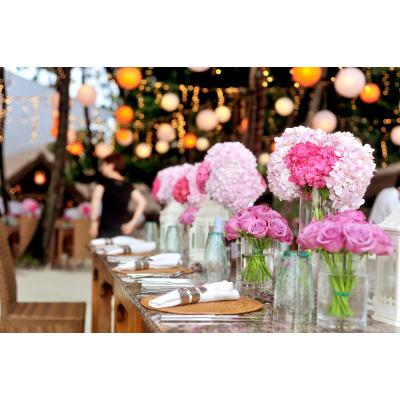
Posted in: World Wedding Customs
 Immediately following a Russian wedding ceremony, the bride and groom climb into a hired car for their Tour of the City. Traditionally, the tour takes place in St. Petersburg.
Immediately following a Russian wedding ceremony, the bride and groom climb into a hired car for their Tour of the City. Traditionally, the tour takes place in St. Petersburg.
Russian Wedding Tour
Close friends and family members may also join the couple on their tour. Sometimes, a long train of hired cars caravan throughout the city. Flowers and golden rings decorate all the vehicles. Sometimes, the couples' names are written on the window of their car. Someone travels along with the bride and groom as their photographer. The photographer must capture images of the couple performing specific tasks at each historical landmark. The tour often lasts the rest of the day. Therefore, the wedding reception typically takes place the following day.St. Petersburg Landmarks
Russian newlyweds typically choose from three to five of the following landmarks to visit on their wedding tour. As mentioned before, the bride and groom must perform certain tasks at each site. Each act symbolizes a long, happy, and prosperous marriage.Senate Square
At Senate Square, along the banks of the Neva River, the bride and groom must have their photo taken with the eternal flame. The eternal flame memorializes the Russian soldiers who lost their lives fighting during World War II. Also in Senate Square, the couple poses with the Bronze Horseman statue and the statue of Peter the Great. Both symbolize St. Petersburg and the ruler who founded the city. The Bronze Horseman draws its name from a poem by Aleksander Pushkin. Perhaps one of the most important works of Russian literature, The Bronze Horseman explores the conflict often evident between the rulers of a state and the citizens who live within it. The statue further symbolizes the protection of such leadership in times of war. Catherine the Great commissioned the statue in 1782. Throughout the following centuries, the Russian people came to believe that as long as the statue remained unharmed, no enemy would succeed in capturing St. Petersburg. During World War II, when St. Petersburg was alternately known as Leningrad, the people built a wooden shelter over the Bronze Horseman and covered it with sandbags. It withstood an astonishing 900 days of bombing and artillery fire during the siege. Surprisingly, it survived with nary a scratch, and Leningrad remained free from enemy rule.Peter Vassilevsky Island
Across the Neva River from the Winter Palace, Peter Vassilvesky Island stands as one of St. Petersburg's most popular tourist sites. Considered part of the administrative division of St. Petersburg, it is home to numerous historical landmarks. Many date back to the 18th century and remain open to tourists to this day. In addition to these historically significant sites, the island also boasts two authentic ancient Egyptian sphinxes and two golden-winged griffins. The two granite sphinxes originally served as guards within Amenhotep III's tomb in Egypt. In the early 1800s, the Russian writer and diplomat, Muravyev saw the sphinxes and knew they needed to adorn the city of St. Petersburg. Muravyev wrote to the Tsar, who made the purchase and arranged for their transport to Peter Vassilvesky Island. More than 3,000 years old, the sphinxes have inspired Russian sculptors to populate the city with even more sphinx statues. Meanwhile, the golden-winged griffins stand guard outside of Griffin's Tower, also on the island. This red brick tower once housed the famous pharmacist William Pell. By day, he concocted potions for healing. By night, he practiced black magic. Rumor has it that he kept real live griffins within the tower during his lifetime. While on their Russian wedding tour, newlywed couples pet the griffins and the sphinxes for the camera.The Rostral Columns
Also located on Peter Vassilvesky Island, Russia's Rostral Columns stand guard over the Strelka (spit) of the island. These grand columns are painted orange and adorned with symbolic prows ("rostra") of conquered enemy ships. The columns were designed by the architect Jean-Francois Thomas de Thomon, who also designed the Old Stock Exchange, which is now a museum on the island. The two columns stand as beacons right where the Bolshaya Neva River splits. Four gigantic statues guard the bases of the two columns, two for each. Each allegorical figure represents one of the Russian rivers - the Volga and the Dnieper (northern column), as well as the Neva and Volkhov (southern column). At first, recessed bowls set into the tops of the columns held hemp oil for burning. Later, the city installed electric lamps. When those became too expensive to operate, the lamps were connected to the city's gas supply. Now, on major Russian holidays, the beacons burn with seven-meter flames. While on their Russian wedding tour, newlyweds who visit the Rostral Columns must link their hands together inside the iron link railing to symbolize their new union.Rubbing Toes & Smashing Crystal
Newlyweds might also visit The Sculptures of Atlantis at the New Hermitage (Winter Palace). Ten giant men, standing in pairs, hold up columns lining a portion of the Winter Palace. The granite men were sculpted by A.I. Terebenev and set in their places in 1848. These sculptures are staggering in their detail and immensity. Not surprisingly, the Russians ascribe magic to these giants. Hence, the tradition for newlyweds to grasp the toes of the sculptures in hopes for many good years of marriage. Another option for Russian newlyweds is a visit to the Peter and Paul Cathedral on Hare Island along the Neva River. This Russian Orthodox cathedral is the perfect place for a bride and groom to smash their crystal glasses, if they haven't already done so during their wedding ceremony. The parents of the bride and groom each give them a crystal glass as part of the wedding festivities. While on their tour of the city, the couple can choose to smash their glasses at the cathedral. First the couple enjoys a champagne toast. Then they break their crystal flutes against a concrete sphere near the fountains. The goal is to smash the glasses into as many splinters as possible. The number of these shards translates to the number of happy years the couple can expect to enjoy together. St. Petersburg offers truly endless historical wonders for couples to visit during their Russian wedding tour. ~Angela Magnotti Andrews5 years ago
4 view(s) 